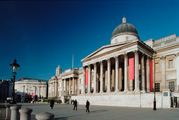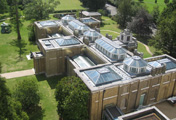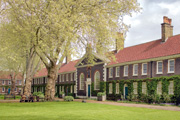Artist and Architect Create A ‘Private Palace of Art’: Leighton House
Originally published in April 2010 in American in Britain Magazine
Fredric, Lord Leighton (1830-1896) was one of the most prominent Victorian artists of his day. Handsome and famous, he enjoyed prestige and status amongst royalty and the upper echelons of London’s cultural circles. His home, the Leighton House Museum, is tucked away off Kensington High Street on the edge of Holland Park. Itconceals an immense variety of hidden treasures. And amongst these treasures none is more beguiling than the famous Arab Hall.
Artist and Architect Create A ‘Private Palace of Art’: Leighton House
By Abby Cronin
Tucked away off Kensington High Street on the edge of Holland Park, the Leighton House Museum conceals an immense variety of hidden treasures. And amongst these treasures none is more beguiling than the famous Arab Hall. Stand in the hall and you will feel as though you have entered a different world, a world which exudes a calm, magical, cool oriental atmosphere. Fredric Leighton and his architect colleague, George Aitchison, were inspired by the reception room of the 12th century palace La Zisa in Palermo, Sicily. They sought to create the grandeur of this room as a setting for Lord Leighton’s large collection of Middle Eastern tiles and artefacts. Leighton had collected original sets of antique panels and groups of tiles while travelling in Damascus. He became so eager to add to his collection that he commissioned British friends living in the Middle East to buy for him. Many tiles date from the 16th and 17th centuries and originated from Ottoman kilns in Turkey and Syria. It was Leighton’s large collection of tiles that prompted the addition of the Arab Hall completed in 1881. Leighton and Aitchison assembled a team of major figures in the Arts and Crafts Movement to work on the hall. Walter Crane designed the mosaic frieze and William De Morgan crafted the borders for the original tile panels together with replacements that were missing. The overall effect is a mesmerising technical achievement whereby old and new tiles were brought together in a spectacular domestic space. The Arab Hall is linked to the main house by the equally stunning Narcissus Hall.(pictured)
Fredric, Lord Leighton (1830-1896) was one of the most prominent Victorian artists of his day. Handsome and famous, he enjoyed prestige and status amongst royalty and the upper echelons of London’s cultural circles. He rose easily through the ranks of the art world to achieve the highest of accolades: Associate of the Royal Academy in 1864, a full Academician in 1868, then President of the Royal Academy in 1878 and a knighthood. In addition to many international honours, he was created Baron Leighton of Stretton in the New Year’s Honours List, 1896, just before his untimely death. With the full approval of Queen Victoria, his burial ceremony took place in St Paul’s Cathedral.
Leighton was born into a comfortable middle class Yorkshire family. With their two daughters and Fredric, the Leightons moved to London in 1833 and then to the Continent in 1841. A generous inheritance enabled the family to enjoy a cosmopolitan lifestyle and to travel extensively in Europe. When the youthful Fredric showed an early talent for drawing, he was enrolled in various schools of art in Berlin, Florence and Frankfurt. Thus began his formal training as an artist. The family returned to England in 1852, leaving Fredric behind with a private income to finish his studies. Upon completing his studies, and now fluent in French, Italian, German and Spanish, Leighton resided in Rome for three years where he produced paintings which he hoped would launch his career. He did not have to wait long for success. It came when he exhibited his large canvas, Cimabue’s Celebrated Madonna at the Royal Academy in 1855 which was quickly purchased by Queen Victoria.
Leighton’s ambitions stimulated a vogue for studio-houses built by fashionable and successful artists in the second half of nineteenth century London. These artists’ colonies were located in desirable areas such as Chelsea, St John’s Wood and Hampstead. But the most prestigious address of all was in Holland Park. The ‘Victorian Olympians’, aka the ‘Holland Park Circle’, sought to promote their work and cultivate the upper echelons of society. Artists such as G.F. Watts, Solomon J. Solomon, Val Princep, William Burges, and Holman Hunt were the celebrities of their day. They held open ‘Show Sundays’ and musical soirées in their studios. Here were occasions to invite collectors and fellow artists to see the latest paintings in luxurious settings. These prestigious dwellings were anything but modest. Journals and newspapers wrote about these artist-studio houses highlighting their architectural plans as well as the lavish interiors. This was the heyday of artistic Kensington. And Fredric Leighton was the pre-eminent figure in this circle.
Upon his return to London in 1859, Leighton had only a modest income. It did not take long for him to recognise that living in rented digs severely restricted his professional and social aspirations. Not content, he wrote to his mother in 1862, “I wish I had a house” and confiding to a friend, “as soon as I can earn the money to pay for it, but I must earn the money first”. His financial status increased apace. He sold his painting Dante in Exile for £1050 in 1864. With increased fortunes from sales of paintings, he was able to buy a plot of land in 1864 from the Holland Estate on Holland Park Road. Next he commissioned his architect friend, George Aitchison, to design a studio-house. They had become friends while living in Rome and both shared a deep appreciation of Italian renaissance and Middle Eastern architecture. Recognising the increasingly competitive and commercial climate of the British art world in the latter half of the 19th century, Leighton knew how important it was to have a residence which could house a working studio, private domestic space, and rooms to entertain royalty and members of the cultural elite, the circles he aspired to move in.
Building commenced in 1865. A conspicuously plain building and front entrance pressed close to the street avoided a defined historical style, maximised the garden area behind the house and may have suggested modest interiors.(pictured) But by 1880, opulence characterised Leighton’s home and studio. Throughout his life he had collected important paintings, oriental carpets, inlaid furniture, valuable antiques, ceramics and tapestries – luxurious furnishings which enhanced the interior rooms and halls.
Phase one of the construction concentrated on providing domestic necessities: a breakfast room, drawing room and dining room. Since he never married and lived alone, there is only one modest bedroom with an adjacent bathroom/dressing room. Kitchens and servants’ rooms were in the basement and two servants’ bedrooms on the top floor. Significantly, it was the staircase which dominated the central space in the L-shaped ground floor plan. In Aitchison’s opinion “well designed staircases are perhaps the most striking features in mansions or public buildings”. (1) The staircase hall served the heart of the house; it was meant to impress. Visitors, collectors and patrons would be escorted up the ornate staircase to Leighton’s studio on the first floor. Original Iznik tiles dating from the early 17th century were installed below the staircase’s picture rail while tiles from Damascus were placed above. Door surrounds were painted black, enriched with incised and gilded decoration. A peacock was perched on the banister and oriental carpets graced tiled floors.(pictured)
In every sense, the studio was where the life of the house revolved.(pictured) In Leighton’s time, it was cluttered with easels, rugs, and tables crowded with books, portfolios and sketches. Enlarged over the years, its sheer size signalled its significance. Not only was this a workshop, it was also Leighton’s main reception room and venue for his popular musical events. Notably, the recent restoration of the house has uncovered a staircase used by Leighton’s models and not seen previously. Speculation about his relationship with his models has never been resolved.
The third extension was completed in 1881 when the Arab Hall was finished. Undoubtedly, this addition met all the requirements Leighton could have wished for. His Sunday afternoon ‘At Homes’ were regular occasions when callers could view the interiors and collections. And his annual spring musical recital was regarded as one the real treats of London’s art scene. Here, finally, was a home and studio where Leighton worked for thirty years, held soirées, and entertained royalty and the rich and famous names of the day. His studio-house was the epitome of a Victorian artist’s home and one of the most prestigious in London.
With remarkable foresight the house was transferred to Kensington Council in 1927 and has been a centre for art and culture ever since. Still a municipal building, it is used as a local museum and links the rich legacy of Victorian art with the present. Closed for refurbishment in 2008, it will re-open from 3rd April 2010, thanks to a £1.6m refurbishment by the Royal Borough of Kensington and Chelsea. Once again the public will be able to enjoy the unique beauty of Leighton House Museum. Now refurbished, the house has been restored to the celebrated ‘private palace of art’ it was in the late nineteenth century.
References:
(1) Leighton House Museum. Guide by D. Robbins & R. Suleman
Published by the Royal Borough of Kensington and Chelsea 2005. p.37
Artists At Home: The Holland Park Circle, 1850-1900. Exhibition Catalogue. Royal Borough of Kensington and Chelsea. 2000
Leighton House Museum is located at 12 Holland Park Road, London W14 8LZ
Website: http://www.rbkc.gov.uk/LeightonHouseMuseum/general/
See Video of Refurbishment
Contact: Abby Cronin
artsjournalist@abbycronin.co.uk
Website: www.abbycronin.co.uk



